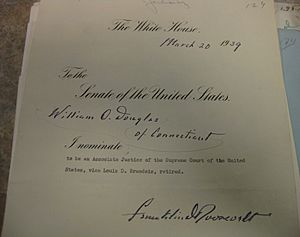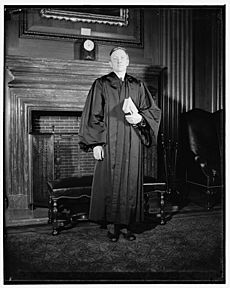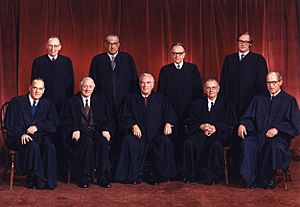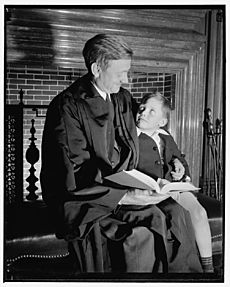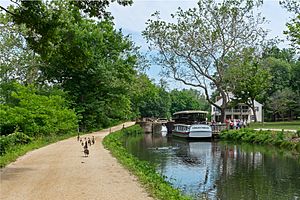William O. Douglas facts for kids
Quick facts for kids
William O. Douglas
|
|
|---|---|
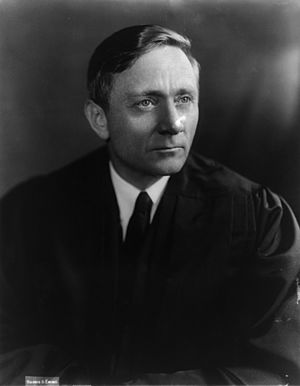
Douglas in the 1930s
|
|
| Associate Justice of the Supreme Court of the United States | |
| In office April 17, 1939 – November 12, 1975 |
|
| Nominated by | Franklin D. Roosevelt |
| Preceded by | Louis Brandeis |
| Succeeded by | John Paul Stevens |
| 3rd Chairman of the Securities and Exchange Commission | |
| In office August 17, 1937 – April 15, 1939 |
|
| President | Franklin D. Roosevelt |
| Preceded by | James M. Landis |
| Succeeded by | Jerome Frank |
| Member of the Securities and Exchange Commission | |
| In office January 24, 1936 – April 15, 1939 |
|
| President | Franklin D. Roosevelt |
| Preceded by | Joseph P. Kennedy Sr. |
| Succeeded by | Leon Henderson |
| Personal details | |
| Born |
William Orville Douglas
October 16, 1898 Maine Township, Minnesota, U.S. |
| Died | January 19, 1980 (aged 81) Bethesda, Maryland, U.S. |
| Political party | Democratic |
| Spouses |
|
| Children | 2 |
| Education | Whitman College (BA) Columbia University (LLB) |
| Military service | |
| Allegiance | United States |
| Branch/service | United States Army |
| Years of service | 1918 |
| Rank | Private |
| Unit | Reserve Officers' Training Corps Student Army Training Corps, Whitman College |
| Battles/wars | World War I |
William Orville Douglas (October 16, 1898 – January 19, 1980) was an American judge. He served as an associate justice of the Supreme Court of the United States. He was known for his strong beliefs in progress and individual freedoms. Many people call him the most liberal justice ever on the U.S. Supreme Court.
President Franklin D. Roosevelt nominated Douglas in 1939. At 40 years old, he was one of the youngest justices appointed to the court. Time magazine called him "the most dedicated civil libertarian ever to sit on the court." Douglas is the longest-serving justice in history. His time on the court lasted 36 years and 211 days, from 1939 to 1975.
Douglas had a childhood where his family moved often. He went to Whitman College on a scholarship. He graduated from Columbia Law School in 1925 and later taught at Yale Law School. Before joining the Supreme Court, he was the third chairman of the Securities and Exchange Commission. Douglas retired from the Court in 1975. John Paul Stevens took his place. Douglas holds many records as a Supreme Court justice, including writing the most opinions.
Some of Douglas's most important opinions include Griswold v. Connecticut. This case established the constitutional right to privacy. This idea was important for later cases like Roe v. Wade. He also wrote the Court's main opinion in cases such as Skinner v. Oklahoma (1942) and Brady v. Maryland (1963). Douglas was also a strong opponent of the Vietnam War. He was a passionate supporter of environmentalism.
Contents
- Early Life and Education
- Military Service
- Law School Journey
- Teaching Law at Yale
- Securities and Exchange Commission
- Serving on the Supreme Court
- Environmentalism and Nature
- Travel Writing
- Presidential Politics
- Attempts to Remove Douglas from Office
- Judicial Record-Setter
- Nicknames
- Retirement from the Court
- Personal Life
- Death and Burial
- Legacy and Honors
- Images for kids
Early Life and Education
Douglas was born in 1898 in Maine Township, Otter Tail County, Minnesota. His father, William Douglas, was a Scottish minister. His mother was Julia Bickford Fisk. His family moved to California and then to Cleveland, Washington. Douglas had a serious illness at age two. His mother believed his recovery was a miracle.
His father passed away in Portland, Oregon in 1904 when Douglas was six. Douglas said his mother was left with very little money. She moved the family, including three young children, to Yakima, Washington. William and his family worked many odd jobs to earn money. A college education seemed impossible.
He was the best student at Yakima High School. He earned a full scholarship to Whitman College in Walla Walla, Washington. At Whitman, Douglas joined the Beta Theta Pi fraternity. He worked as a waiter and janitor during school. In the summer, he worked in a cherry orchard. Douglas later said picking cherries inspired him to become a lawyer.
Douglas was invited to join Phi Beta Kappa, a respected academic honor society. He was on the debate team and became student body president in his last year. After graduating in 1920 with a degree in English and economics, he taught English and Latin at his old high school for two years. He hoped to save enough money for law school.
Military Service
In the summer of 1918, Douglas joined a U.S. Army Reserve Officers' Training Corps training camp. This was at the Presidio of San Francisco. That fall, he joined the Student Army Training Corps at Whitman as a private. He served from October to December. He was honorably discharged because Armistice of November 11, 1918 ended World War I.
Law School Journey
Douglas traveled to New York to attend Columbia Law School. He worked tending sheep on a train to get free passage. His fraternity helped him survive in New York. He borrowed $75 from a fraternity brother to enroll at Columbia.
After six months, Douglas was running out of money. The law school helped him find a job preparing a correspondence course for law. He earned $600, which allowed him to stay in school. He saved $1,000 by the end of the semester. In August 1923, Douglas married Mildred Riddle. He had known her in Yakima. Douglas graduated second in his class at Columbia in 1925.
In the summer of 1925, Douglas started working at a law firm called Cravath, DeGersdorff, Swaine and Wood. He had tried to get a job as a Supreme Court clerk for Harlan F. Stone, but did not get it.
Teaching Law at Yale
Douglas left the Cravath firm after four months. After a year, he moved back to Yakima. He soon regretted this and never practiced law there. After a period of not working and another short time at Cravath, he started teaching at Columbia Law School. He then joined the faculty of Yale Law School. There, he became an expert in commercial litigation and bankruptcy law.
He was part of the legal realist movement. This group believed law should be understood by its real-world effects, not just strict rules. Robert Maynard Hutchins called Douglas "the most outstanding law professor in the nation."
Securities and Exchange Commission
In 1934, Douglas left Yale. President Franklin Roosevelt nominated him to the Securities and Exchange Commission (SEC). The SEC is a government agency that protects investors. By 1937, Douglas became an important adviser and friend to the President. He also became friends with other young government officials.
Serving on the Supreme Court
In 1939, Justice Louis D. Brandeis retired from the Court. President Roosevelt nominated Douglas to replace him on March 20. Douglas was Brandeis's personal choice. Douglas said he was surprised by the appointment. He was confirmed by the United States Senate on April 4 by a vote of 62 to 4. He was sworn in on April 17, 1939. At 40, Douglas was one of the youngest justices on the Supreme Court.
Working with Other Justices
Douglas often disagreed with fellow justice Felix Frankfurter. Frankfurter believed judges should not get involved in politics. Douglas did not always think judges needed to follow past decisions strictly. Their disagreements were often intense.
Douglas was known for writing short, powerful opinions. He often wrote them quickly, sometimes publishing his first draft. He was also known for working very hard.
Douglas's Judicial Beliefs
Douglas believed a judge's role was not neutral. He said, "The Constitution is not neutral. It was designed to take the government off the backs of the people."
He was a strong supporter of civil libertarianism. This means he believed in protecting individual rights and freedoms. Douglas was known for strongly defending First Amendment rights, like freedom of speech. He and Justice Hugo Black believed the First Amendment's rule that "no law" should restrict speech should be taken literally.
He wrote the opinion in Terminiello v. City of Chicago (1949). This case overturned the conviction of a priest who was accused of disturbing the peace with his speech. Douglas also disagreed with the Court's decision in Dennis v. United States (1952). This case upheld the conviction of a leader of the U.S. Communist Party. Douglas believed that "The way to combat bad ideas is with other ideas. The way to combat lies is with truth."
Douglas was suspicious of majority rule when it came to social and moral issues. He often worried about people being forced to conform. He was considered the most liberal justice in the Supreme Court's history. He voted to end the death penalty in Furman v. Georgia. He also argued that the Vietnam War was unconstitutional because Congress had never officially declared war.
Douglas was also a supporter of gay rights before the Stonewall riots. He disagreed with a ruling that allowed the deportation of gay and lesbian individuals. He argued that the term used to describe them was too vague.
The Rosenberg Case
On June 17, 1953, Douglas temporarily stopped the execution of Ethel and Julius Rosenberg. They had been found guilty of selling atomic bomb plans to the Soviet Union. Douglas believed the judge had sentenced them to death without the jury's consent. This was allowed under the old law, but a newer law said only a jury could decide the death penalty.
Because of this decision, Douglas faced attempts to remove him from the Court. However, these attempts did not succeed.
Views on the Vietnam War
Douglas had strong opinions about the Vietnam War. In 1952, he visited Vietnam and met with Ho Chi Minh. He later became friends with Ngo Dinh Diem. Douglas helped promote U.S. support for Diem.
After Diem's death in 1963, Douglas became very critical of the war. He believed the war was illegal. He often disagreed when the Court chose not to hear cases challenging the war. In 1968, Douglas tried to block the shipment of Army reservists to Vietnam. However, the other eight justices quickly overturned his order.
In 1973, Douglas ordered the military to stop bombing Cambodia. He held a hearing in the Yakima federal courthouse. He said, "we live in a world of confrontations. That's what the whole system is about." The U.S. military ignored his order. Six hours later, the other eight justices met and unanimously overturned Douglas's ruling.
Environmentalism and Nature
In his book Of Men and Mountains (1950), Douglas wrote about his childhood connection to nature. In the 1950s, there were plans to build a road along the C&O Canal. Douglas, who often hiked the Canal towpath, opposed this plan. He challenged reporters to hike the 185-mile length of the Canal with him. After the hike, a major newspaper changed its mind. Douglas is widely credited with saving the Canal. It became a National Historic Park in 1971.
He served on the board of directors of the Sierra Club from 1960 to 1962. He wrote many books about his love for the outdoors. In 1962, Douglas wrote a positive review of Rachel Carson's book Silent Spring. This book helped start the modern environmental movement.
He also helped save the Red River Gorge in eastern Kentucky. A proposal to build a dam there reached the Supreme Court. Douglas visited the area himself. The Red River Gorge's Douglas Trail is named after him.
In 1962, Douglas and his wife canoed down the Buffalo River in Arkansas. This experience made him a fan of the river. Douglas was important in getting the Buffalo River protected as America's first National River.
Douglas was known as an outdoorsman. He reportedly hiked the entire 2,000-mile Appalachian Trail. His love for nature influenced his legal decisions. His active role in protecting wilderness earned him the nickname "Wild Bill."
In 1967, Douglas led a hike to save Sunfish Pond on the Appalachian Trail in New Jersey. Over a thousand people joined him. He said it was important to save some wilderness from human development.
Travel Writing
From 1950 to 1961, Douglas traveled widely in the Middle East and Asia. He wrote many books about his experiences and observations during these trips. He was one of the few American travel writers to visit these distant regions at that time. His travel books include:
- Strange Lands and Friendly People (1950)
- Beyond the High Himalayas (1952)
- North From Malaya (1953)
- Russian Journey (1956)
- Exploring the Himalaya (1958)
- West of the Indus (1958)
- My Wilderness, The Pacific West (1960)
- My Wilderness, East to Katahdin (1961)
In his memoir, The Court Years, Douglas said he was sometimes criticized for taking too much time off from the Court to write travel books. However, Douglas believed his travels gave him a global view. He felt this perspective helped him with cases before the Court. It also showed him how political systems worked without the legal protections found in the American Constitution.
Presidential Politics
Douglas was considered as a possible Vice President. In 1944, President Franklin D. Roosevelt decided not to support his current Vice President, Henry A. Wallace. A list of possible replacements was made. This list included Douglas.
Five days before the Vice President was chosen, Roosevelt sent a letter. It said his choice would be either "Harry Truman or Bill Douglas." Harry S. Truman was nominated. Douglas received a few votes.
In 1948, Douglas's hopes for president were renewed. Many Democrats thought Truman could not win the election. They looked for another candidate. A "Draft Douglas" campaign started in New Hampshire and other states. Douglas campaigned briefly but then withdrew. Truman later asked Douglas to be his Vice President, but Douglas declined.
Attempts to Remove Douglas from Office
Political opponents tried twice to remove Douglas from the Supreme Court. Both attempts were unsuccessful.
After the Rosenberg Case
On June 17, 1953, U.S. Representative William M. Wheeler of Georgia tried to impeach Douglas. This was because Douglas had briefly stopped the execution in the Rosenberg case. The attempt to investigate the charges ended quickly.
1970 Attempt
Douglas often gave speeches and wrote books to earn more money. He faced financial difficulties due to his divorces.
Douglas became president of the Parvin Foundation. House Minority Leader Gerald Ford targeted Douglas because of his ties to this foundation. Ford was also upset that Douglas's friend, Abe Fortas, had to resign from the Court due to similar issues. Ford tried to impeach Douglas in April 1970.
The hearings began in late April 1970. Ford was the main witness. He criticized Douglas's "liberal opinions" and his ties to the foundation. Douglas was also criticized for accepting money for an article he wrote. It became clear that the impeachment would not succeed. The proceedings ended without a public vote.
Some scholars believe Ford's impeachment attempt was politically motivated. They note that Ford and President Nixon were angry about the Senate not confirming other judges. Nixon also disliked Douglas. The attempt to impeach Douglas was also seen as a way to gain support from Southern Democrats.
Judicial Record-Setter
During his time on the Supreme Court, Douglas set several records that still stand. He served on the U.S. Supreme Court for over 36 years (1939–1975). This is longer than any other justice. During these years, he wrote about 30 books in addition to his opinions and dissenting opinions. He also gave more speeches than any other justice.
Nicknames
Douglas had several nicknames from both people who admired him and those who did not. The most common nickname was "Wild Bill." This referred to his independent and often surprising views. It also referred to his "cowboy" style.
Retirement from the Court
Since the 1970 impeachment hearings, Douglas wanted to retire. He did not want to retire while a Republican was president. He said, "I won't resign while there's a breath in my body —until we get a Democratic President."
On December 31, 1974, at age 76, Douglas had a stroke. It paralyzed his left leg and made him use a wheelchair. Douglas was very disabled but insisted on continuing to work. Seven of his fellow justices voted to postpone any cases where Douglas's vote might matter. Douglas finally retired on November 12, 1975, after 36 years of service. He was the last Supreme Court justice appointed by President Roosevelt.
Douglas's resignation was sent to President Gerald Ford, who had tried to impeach him. Ford later hosted Douglas and his wife at a White House dinner. Ford said, "We had had differences in the past, but I wanted to stress that bygones were bygones."
Douglas believed he could still serve as a senior judge. He tried to continue working on cases even after John Paul Stevens took his seat. Douglas was very angry when he found his clerks had been reassigned. He tried to file opinions in cases he had heard before retiring. Chief Justice Warren Burger ordered all staff to refuse to help Douglas with these efforts. In March 1976, the nine sitting justices sent him a letter. It told him his retirement had ended his official duties. Only then did Douglas stop trying to work on Supreme Court business.
Personal Life
Douglas's first wife was Mildred Riddle, a teacher. They married on August 16, 1923. They had two children, Mildred and William Jr. They divorced on July 20, 1953. William Douglas Jr. became an actor.
In October 1949, Douglas broke thirteen ribs after falling from a horse. He did not return to the Court until March 1950. Four months later, he was hospitalized again after being kicked by a horse.
Douglas married Mercedes Hester Davidson on December 14, 1954. They divorced in 1963. Later that year, he married Joan "Joanie" Martin on August 5, 1963. They divorced in 1966. On July 15, 1966, Douglas married Cathleen Heffernan. They stayed together until his death in 1980.
Death and Burial
Douglas passed away at age 81 on January 19, 1980, at Walter Reed Hospital. He was survived by his fourth wife, Cathleen Douglas, and his two children.
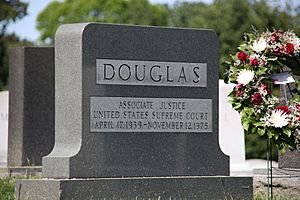
Douglas is buried in Arlington National Cemetery. This is near the graves of eight other former Supreme Court justices. His headstone says he was a U.S. Army private during World War I. Records show he served in the Student Army Training Corps in 1918. This service qualified him for burial in Arlington.
Legacy and Honors
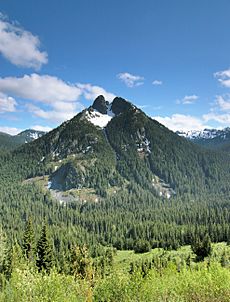
- In 1962, Douglas received the National Audubon Society's highest honor, the Audubon Medal.
- The William O. Douglas Wilderness was named after him in 1984. It is near Mount Rainier National Park in Washington State.
- Douglas Falls, in North Carolina, is supposedly named for him.
- The William O. Douglas Outdoor Classroom in Beverly Hills, California, is named for him.
- He was elected to the Ecology Hall of Fame for his work in conservation.
- The William O. Douglas Honors College at Central Washington University is named for him.
- The William O. Douglas Federal Building in Yakima, Washington, was renamed in his honor in 1978.
- Since 1972, the William O. Douglas Committee at Gonzaga University School of Law has sponsored lectures on the First Amendment in his honor. Douglas was the first speaker.
- A statue of Douglas was placed at A.C. Davis High School in Yakima, Washington, in 1978.
- William O. Douglas Hall at his alma mater, Whitman College, is named in his honor.
- Douglas Hall at Earl Warren College, University of California, San Diego, is also named for him.
- In 1977, a bust of Douglas was put along the towpath of the C & O Canal in Washington, DC. The C & O Canal National Historical Park was officially dedicated to Douglas. This honored his efforts to preserve the historic canal.
- Douglas Trail, which leads to the Appalachian Trail and Sunfish Pond in New Jersey, is named after him.
- Mountain - The Journey of Justice Douglas is a play about his life.
Images for kids
-
Grave of William O. Douglas at Arlington National Cemetery.
-
William O. Douglas Wilderness outside Yakima, Washington


